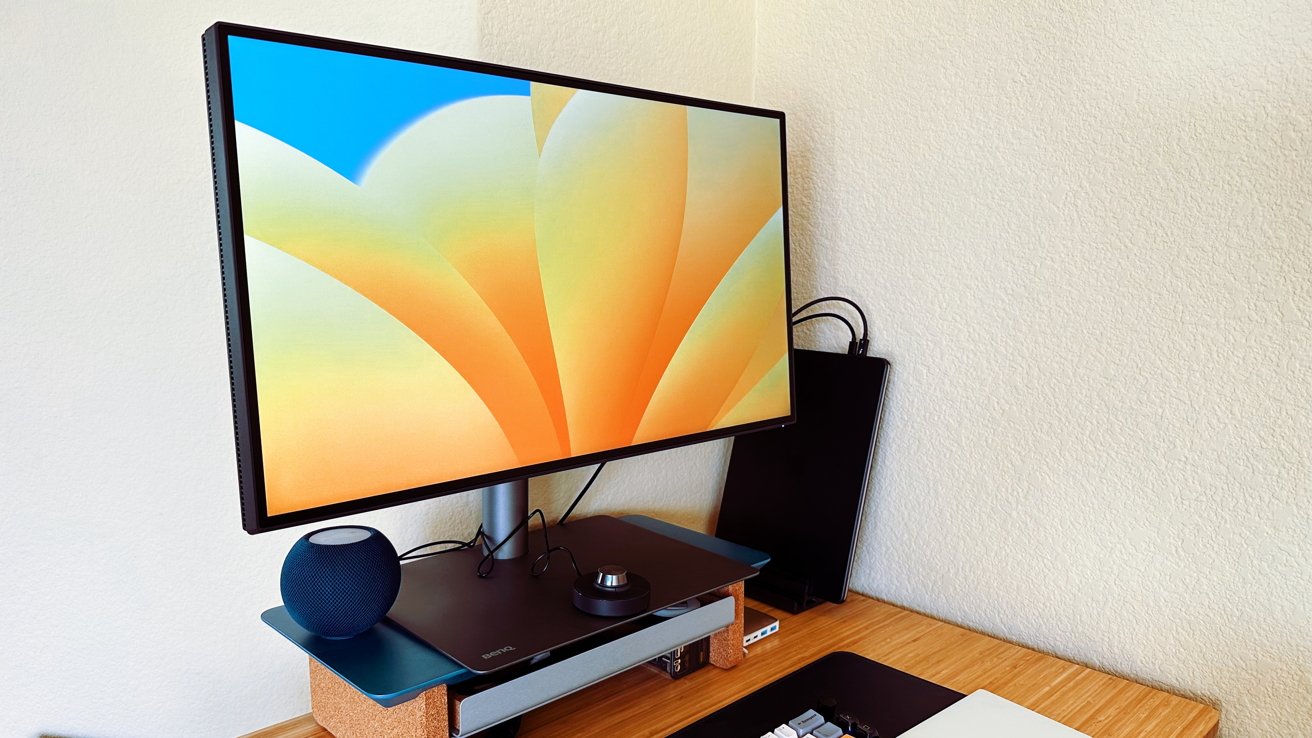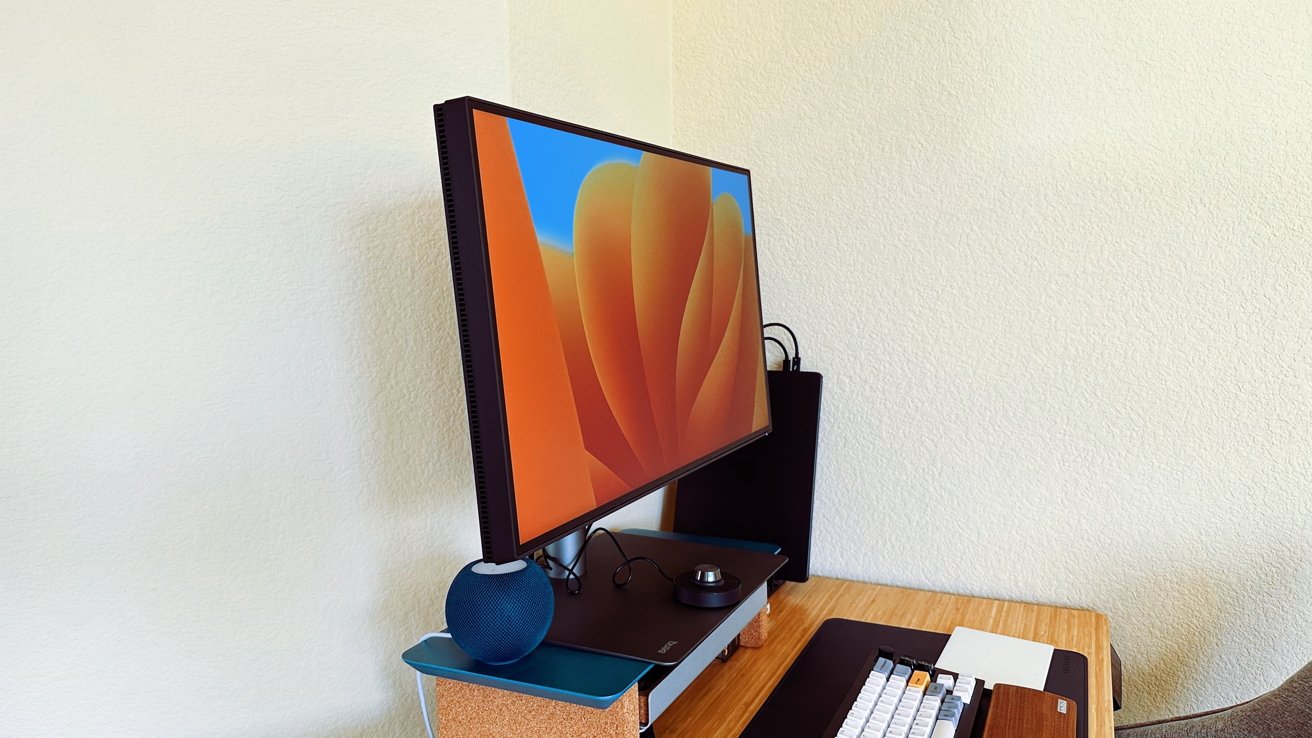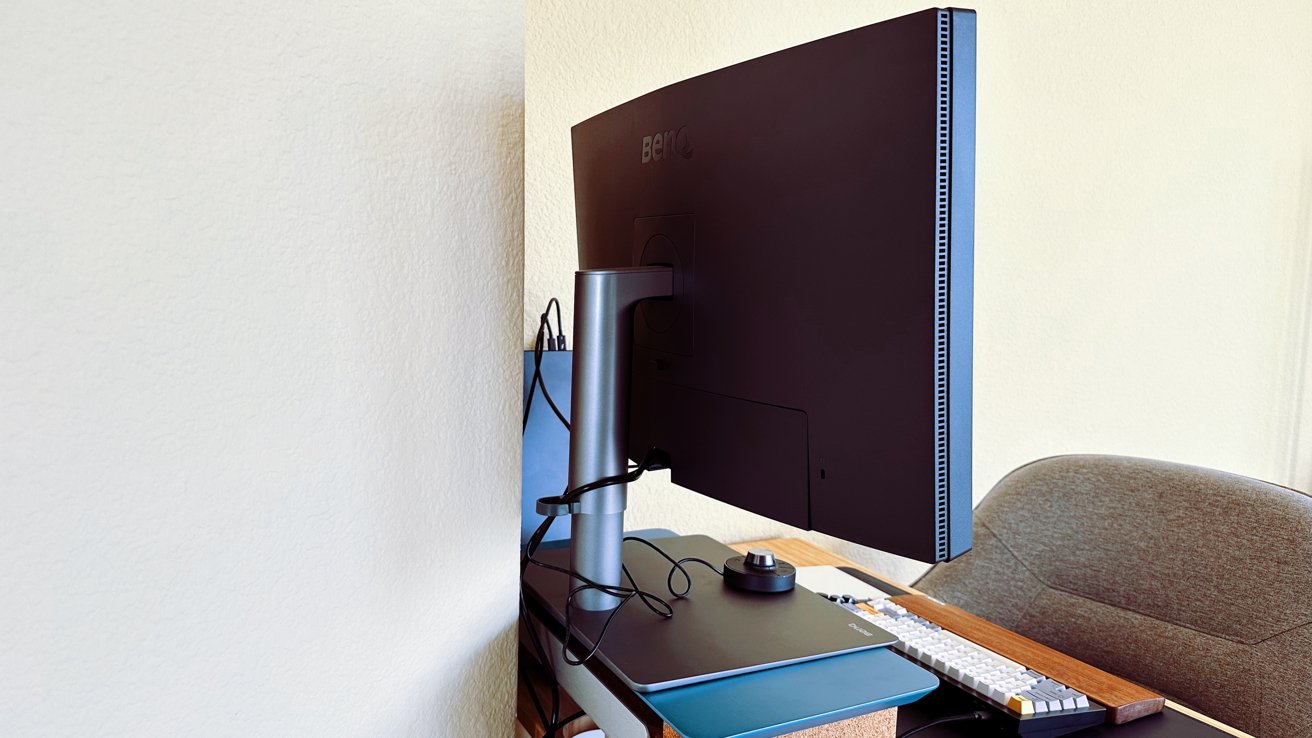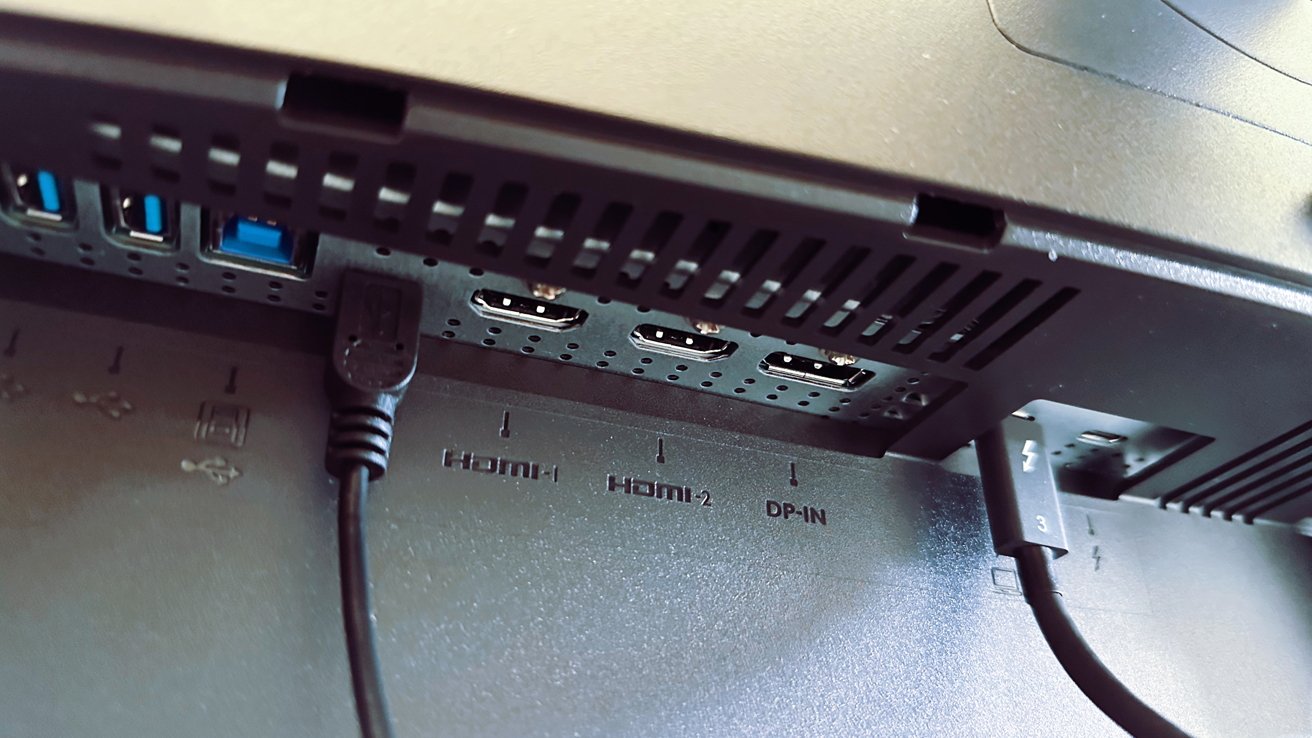BenQ PD2725U review: Not even close to a Studio Display substitute
The 27-inch, 4K BenQ PD2725U monitor is advertised as a "Mac compatible" display, and it worked with our MacBook Air with M2 -- but it's clear this display wasn't designed for Mac users.

BenQ PD2725U
The obvious thing worth pointing out is that this is a 27-inch monitor with a 4K resolution. Apple's macOS looks the best when there's a certain number of pixels per inch, and this monitor with 163ppi falls short -- it's not in the retina range.
BenQ pushes the PD2725U as a color-accurate display, presumably to target photographers and designers, but the non-native resolution issue remains glaring.
Even for us, primarily using the monitor for writing and basic image manipulation, the monitor felt lackluster with less-than-crisp text, and strangely larger UI elements.
The specs that jumped out to us were the display's 163 pixels per inch and 400 nits of peak HDR brightness -- 250 nits of brightness on average.

BenQ PD2725U is 27 inches with a 4K resolution
If your goal is strictly color reproduction, using BenQ's software may be helpful. The company has proprietary software to ensure the design you see on screen is what you see when printed on paper. We'll assume the category of professionals targeted with this monitor is more niche than we can appreciate, very focused on specific color reproduction.
For us, however, using the monitor more broadly and for everyday tasks, we much preferred our Studio Display for the complete experience, from visuals and built-in speakers to exterior design.
Going with Apple's Studio Display completes the circle of computer, operating system, and monitor. It simplifies the settings and configuration process. As we've discussed before, display scaling will help the visual impacts of macOS user interface for non-retina monitors, but it's not perfect.
It was hard to find a sweet spot between items being too large or too small on screen when we sat about 22 inches away. Windows took up more room and decreased the usefulness of having a screen of this size on our desk.

The back of the monitor
The stand is not revolutionary in its mechanics, but it works well to push it up or down with a single finger and stay at the desired height. That was the primary highlight of the product.
The actual footprint of the stand was massive. The ports on the back were difficult to get to and then covered by a plastic piece that was not easy to snap on or off.
We liked that the monitor came with nearly every cable you would want to use, including Thunderbolt, HDMI, Display Port, and USB-C. Unfortunately, the Thunderbolt 3 cable in the box is only 27 inches from tip to tip. Apple's included cable looked massive at 39 inches.
On the back are two HDMI 2.0 inputs, one DisplayPort 1.4 input, and two Thunderbolt 3 ports. The first Thunderbolt 3 port supports 65W of power delivery, while the second supports up to 15W.
There's also KVM functionality to connect two computers and switch back and forth between them.
The BenQ PD2725U comes with the Hotkey Puck G2. It's a controller to adjust the monitor settings without reaching for the buttons behind it.

The monitor's ports
The idea is cool, but the puck accessory is another cord strung across the desk. The keys on the puck can be set for different color profiles if you want quick access to multiple ones.
The two 2.5W speakers on the PD2725U were not good by any standards. They sounded thin and hollow for both spoken word and music. One example of this: we couldn't tell whether the sound was coming out of a closed MacBook Air or the monitor's speakers at one point.
Even compared to dedicated desktop speakers, the Studio Display's audio sounded respectable.
Right next to the product's name, when you go to buy it on BenQ's website, it says, "Mac compatible." That's what it felt like to use it. The monitor was compatible, but it didn't feel like it had Mac users in mind when it crafted this product.
Photographers and designers concerned with color reproduction may find BenQ's features like Paper Color Sync -- software that simulates paper printing results -- useful. However, those professionals will also be frustrated with the 4K resolution at a 27-inch size when connected to their Mac.
For non-professionals, a $700 price difference between Apple's Studio Display and the PD2725U could be a hurdle for people on a budget.
In this case, we recommend shopping for a less expensive monitor. Dell's S2722QC, for example, will be able to cover the same general purpose computing needs for $400.
There's also the option of buying a refurbished Studio Display directly from Apple for $1,360 if you're set on a first-party solution.
On steep sale, the BenQ PD2725U likely has its place in plenty of corporate workplaces with Thunderbolt 3 connectivity and an eye on color reproduction. But, it's probably not for most Mac users.
Read on AppleInsider

BenQ PD2725U
The obvious thing worth pointing out is that this is a 27-inch monitor with a 4K resolution. Apple's macOS looks the best when there's a certain number of pixels per inch, and this monitor with 163ppi falls short -- it's not in the retina range.
BenQ pushes the PD2725U as a color-accurate display, presumably to target photographers and designers, but the non-native resolution issue remains glaring.
Even for us, primarily using the monitor for writing and basic image manipulation, the monitor felt lackluster with less-than-crisp text, and strangely larger UI elements.
BenQ PD2725U monitor review - Look and feel
BenQ calls the PD2725U a designer monitor and lists it on its website under a section for professionals. In this case, we're assuming that BenQ's classification of pro is different than Apple's.The specs that jumped out to us were the display's 163 pixels per inch and 400 nits of peak HDR brightness -- 250 nits of brightness on average.

BenQ PD2725U is 27 inches with a 4K resolution
If your goal is strictly color reproduction, using BenQ's software may be helpful. The company has proprietary software to ensure the design you see on screen is what you see when printed on paper. We'll assume the category of professionals targeted with this monitor is more niche than we can appreciate, very focused on specific color reproduction.
For us, however, using the monitor more broadly and for everyday tasks, we much preferred our Studio Display for the complete experience, from visuals and built-in speakers to exterior design.
Going with Apple's Studio Display completes the circle of computer, operating system, and monitor. It simplifies the settings and configuration process. As we've discussed before, display scaling will help the visual impacts of macOS user interface for non-retina monitors, but it's not perfect.
It was hard to find a sweet spot between items being too large or too small on screen when we sat about 22 inches away. Windows took up more room and decreased the usefulness of having a screen of this size on our desk.
BenQ PD2725U monitor review -- Stand and cord organization
Right out of the gate, we liked the BenQ adjustable stand that the monitor came with -- included in the price even!
The back of the monitor
The stand is not revolutionary in its mechanics, but it works well to push it up or down with a single finger and stay at the desired height. That was the primary highlight of the product.
The actual footprint of the stand was massive. The ports on the back were difficult to get to and then covered by a plastic piece that was not easy to snap on or off.
We liked that the monitor came with nearly every cable you would want to use, including Thunderbolt, HDMI, Display Port, and USB-C. Unfortunately, the Thunderbolt 3 cable in the box is only 27 inches from tip to tip. Apple's included cable looked massive at 39 inches.
On the back are two HDMI 2.0 inputs, one DisplayPort 1.4 input, and two Thunderbolt 3 ports. The first Thunderbolt 3 port supports 65W of power delivery, while the second supports up to 15W.
There's also KVM functionality to connect two computers and switch back and forth between them.
The BenQ PD2725U comes with the Hotkey Puck G2. It's a controller to adjust the monitor settings without reaching for the buttons behind it.

The monitor's ports
The idea is cool, but the puck accessory is another cord strung across the desk. The keys on the puck can be set for different color profiles if you want quick access to multiple ones.
BenQ PD2725U monitor review -- Sound and video
The sound was terrible, and there was no video camera. However compromised the video camera might be on the Studio Display, one is still integrated as an option.The two 2.5W speakers on the PD2725U were not good by any standards. They sounded thin and hollow for both spoken word and music. One example of this: we couldn't tell whether the sound was coming out of a closed MacBook Air or the monitor's speakers at one point.
Even compared to dedicated desktop speakers, the Studio Display's audio sounded respectable.
Studio Display or BenQ PD2725U?
This BenQ monitor retails for $899. At full retail price, this is not the all-purpose 27-inch monitor we would spend that kind of money on to use with our Mac.Right next to the product's name, when you go to buy it on BenQ's website, it says, "Mac compatible." That's what it felt like to use it. The monitor was compatible, but it didn't feel like it had Mac users in mind when it crafted this product.
Photographers and designers concerned with color reproduction may find BenQ's features like Paper Color Sync -- software that simulates paper printing results -- useful. However, those professionals will also be frustrated with the 4K resolution at a 27-inch size when connected to their Mac.
For non-professionals, a $700 price difference between Apple's Studio Display and the PD2725U could be a hurdle for people on a budget.
In this case, we recommend shopping for a less expensive monitor. Dell's S2722QC, for example, will be able to cover the same general purpose computing needs for $400.
There's also the option of buying a refurbished Studio Display directly from Apple for $1,360 if you're set on a first-party solution.
On steep sale, the BenQ PD2725U likely has its place in plenty of corporate workplaces with Thunderbolt 3 connectivity and an eye on color reproduction. But, it's probably not for most Mac users.
BenQ PD2725U monitor review -- Pros
- Height adjustable stand worked well
- Array of port options was handy
BenQ PD2725U monitor review -- Cons
- Non-native Mac resolution
- Port connections were difficult to get to
- Poor sounding internal speakers
Rating: 2.5 out of 5
This monitor is available for purchase at B&H Photo for $849.99 or directly from BenQ for $899.Read on AppleInsider

Comments
This specific BenQ display is a bit odd, as Thunderbolt adds significantly to the price, but doesn't bring a ton of benefits these days. It probably makes the most sense for a MacBook Air owner looking for a 1-cable solution that also charges the laptop, since the 65W limitation is a bit low for the MacBook Pro (though it will certainly work, depending on how hard you're working the CPU/GPU). For anyone with other easy connection options - USB-C, DisplayPort, or HDMI - you can get similar features for a lot less, or more features for a similar price. The review would have been more useful by concentrating on that issue and comparing it to similar displays without Thunderbolt than spending so much time on it not being "Retina".
Even though it's hard to resolve the individual pixels from a 27" 4K from a relatively short distance, "vernier acuity" does allow us to discern a shaper image from the finer pixel pitch of the 27" 5K from the same distance. OK, not only am I spoiled, but I am picky too...
Still, consider this: the pixel pitch (or DPI) of a 27" 5K is still less than a run-of-the-mill laser printer of 300 DPI, and many printers are 600 DPI and greater. We seem to think 300 DPI is the bare minimum for the printed page, so why not screens? I may hold printed pages closer than a 27" screen, but not closer than laptop or iPad screens.
Too bad the Studio Displays are so much more expensive than typical 4K screens. I'm not saying they aren't worth it, but I keep checking if there are any "basic" 5K screens out there for a reasonable price for a home office set up and haven't found one yet. Even the LGs are a pretty penny. And why isn't there a standalone 24" 4.5K screen like in the newer iMacs?
it may not be exactly built for a Mac, but it’s calibrated, colors are bright and crisp and has great 4K resolution for what it is. Hooked up to both of my MacBook Pros I can switch between both laptops using one monitor. I do pro editing work and editing video on it has great to do. It supports a lot of display profiles when I need to switch and is Rec. 709. something of a requirement for my work. It’s nothing to sneeze at and at less money than the Apple display, most anyone would love to have it.
in short, your opinion is your own, but don’t rant about something you don’t use as a daily driver just so you can write an article for on a site dedicated to Apple. Frankly anyone could appreciate what the monitor does have and be quite satisfied with it. I give my BenQ monitor a 4.5 out of 5.
Using a 27” 5K and a 27” 4K monitor side by side with both using default scaling would have the 5K display desktop with fonts, menus, and windows scaled to 2560 and the 27” 4K monitor scaled to 1920 and the latter (4K) would have fonts, windows, menus, etc., that are noticeably larger.
To overcome the differences in presentation between the 4K display and the 5K display the video for the 4K display can be scaled to a non-default setting to make it perfectly match the scaling of fonts, windows, menus, etc. as the 5K display. The downside is that doing non-default scaling requires more GPU processing and resources since it is no longer a relatively simple pixel doubling. The end result of non-default scaling, at least on Macs, is quite excellent visually but puts more load on the GPU. This extra load may be an impediment for graphics intensive applications.
I use non-default scaling on my 27” 4K secondary monitor to exactly match the default scaling of the 27” 5K Studio Display. It works wonderfully and I can drag screen elements between the screens as if the two screens are one big screen. Windows can be straddled between the two screens without a problem, even if one screen is in a different orientation and the screen element is in the view portal of both monitors. If both screens were are at different equivalent DPIs I don’t think you could straddle anything across the two screens.
I’ve never run into any issues with display scaling on Macs. I’ve been using it on the built-in screens on all of my MacBook Pros to get more desktop real estate. Access to this setting is in the macOS Display preferences.
The main feature of this monitor is the colour profile it supports and thunderbolt connectivity, and they have been absolutely disregarded in this review. (not even mentioned in Pros section) It's almost like buying a sports car and bitching about its uncomfortable seats, etc.
The Apple Studio display is 5K and if you do a simple maths the pixel density is about the same on BENQ PD2725U
This review basically ditching the BENQ one for not being a 5K and not having fancy speaker and webcam, despite it costs about half. The cable management is probably not the best but it is very common configuration among many other brands.
End up giving it 2.5/5 ???? Come on ... really